mobile View, to the German Version tap the flag


- Autonomous Region of Spain
- until 1715 as County of Barcelona part of the united crown of Aragon
- own names:
– Catalan: Catalunya
– Aranese: Catalonha
– Spanish: Cataluña
• Flag
• Historical and other Flags
• Meaning/Origin of the Flag
• Coat of Arms
• Historical Coats of Arms
• Meaning/Origin of the Coat of Arms
• Map of the autonomous regions of Spain
• Map of the historic Kingdoms on the Iberian Peninsula
• Numbers and Facts
• History
• Origin of the Country's Name

since 1977,
Flag of Catalonia,
ratio = 2:3,
Source, by: Flags of the World






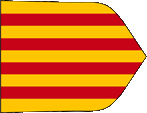
875–14th century,
Flag of the County of Barcelona,
Source, by: Wikipedia (FR)




14th–16th century,
Flag of the County of Barcelona,
Source, by: Wikipedia (FR)






1933–1935,
Flag of Catalonia,
Source, by: Wikipedia (ES)





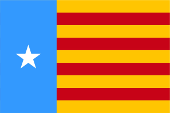
1933–1935,
Flag of Catalonia,
ratio = 2:3,
Source, by: Flags of the World




1933–1935,
Flag of Catalonia,
variant,
ratio = 2:3,
Source, by: World Statesmen



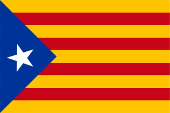
Flag of the independence movement,
ratio = 2:3,
Source, by: Wikipedia (DE)



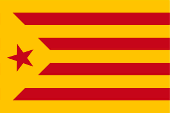
Flag of the independence movement,
ratio = 2:3,
Source, by: Wikipedia (DE)




The current flag of Catalonia was officially reintroduced on 18th of December in 1979. It is called Senyera and shows four horizontal red stripes on a golden background. It is a typical heraldic flag, created by rotating and attaching the heraldic image to a flagpole. Before his death in 1137, King Ramiro II of Aragon appointed his newborn daughter Petronella as heiress, who married Raimund Berengar IV, Count of Barcelona (Catalonia) in 1150. Thus was born the united Crown of Aragon under the arms of Raimund Berengar IV, which was extended to include the Balearic Islands in 1228–1232 and the county of Valencia in 1238. For the united Crown of Aragon, the very memorable flag of the County of Barcelona/Principality of Catalonia is adopted, which – like its coat of arms – shows four vertical red bars on a golden background. The united Crown of Aragon was dissolved in 1715, Catalonia became a Spanish province, but remained the nominal county of Barcelona. In the Spanish Republic (from 1931), an Autonomous Region of Catalonia was created on 21st of September in 1932, which officially re-adopted the Senyera on 25th of May in 1933. In the meantime, however, unofficial variants of the flag had already been used, which additionally showed a light blue triangle on the mast or a light blue bar with a white five-pointed star in it. Autonomy was then abolished again in 1935, but parliament was allowed to be restricted again from 1936 to form a new government, which now probably/presumably used the previously unofficial variant with the light blue bar and the white five-pointed star in it. The Senyera was banned between 1939 and 1975 under the reign of the Spanish nationalist General Franco. Political and cultural groups of modern times that want to preserve and promote the identity of Catalonia, or even desire the independence of the country, usually use the flag of Catalonia supplemented by a blue triangle on the mast with a white five-pointed star in the middle, called "Estelada Blava". However, there is also a variant with a yellow triangle on the pole and a red star, called "Estelada Groga", which is used by left-wing nationalists.
Source:
Wikipedia (ES),
Flags of the World,
Volker Preuß


since 1977,
Coat of arms of Catalonia,
Source, by: Xavi Garcia, CC BY-SA 3.0, via Wikimedia Commons


from ca. 12th century,
Coat of arms of the Counts of Barcelona,
Source, by:
Wikipedia (DE)

The present coat of arms of Catalonia, like the flag, was officially reintroduced in connection with the creation of the Autonomous Community of Catalonia on 29th of September in 1977. It shows four red bars on a golden background, above which is a royal crown. The shield is the coat of arms of the County of Barcelona and of the later united Crown of Aragon in 1150. Before his death in 1137, King Ramiro II of Aragon appointed his newborn daughter Petronella as heiress, who married Raimund Berengar IV, Count of Barcelona (Catalonia) in 1150. Thus was born the united Crown of Aragon under the arms of Raimund Berengar IV, which was extended to include the Balearic Islands in 1228-1232 and the county of Valencia in 1238. According to legend, the coat of arms of the County of Barcelona was granted to Wilfried the Hairy (Guifré el Pilós), Count of Barcelona, by the West Frankish King Charles the Bald around 875, because he had shown bravery in the fight against the Moors (Arabs). Legend has it that a fighter drew the four bleeding fingers of his hand through the count's coat of arms, which was valid until then. Count Raimund Berengar III of Barcelona, however, had a completely different interpretation of his coat of arms drawn up around the year 1100, which records the following: The coat of arms is red and shows three golden bars. They stand for the three pillars of power in the County of Barcelona, namely Barcelona itself, the Lordship of Besalú and the Lordship of Provenca. It is possible that the naval flag allegedly used by Aragon from 1263 onwards goes back to this interpretation. The colours red and gold allegedly go back to the influence of the Pope, because the old kingdom of Aragon and the county of Barcelona were fiefs of the Holy See, and therefore used the colours of the city of Rome.
Source: Wikipedia (ES),
Wikipedia (CA),
Volker Preuß

The autonomous Regions of Spain:
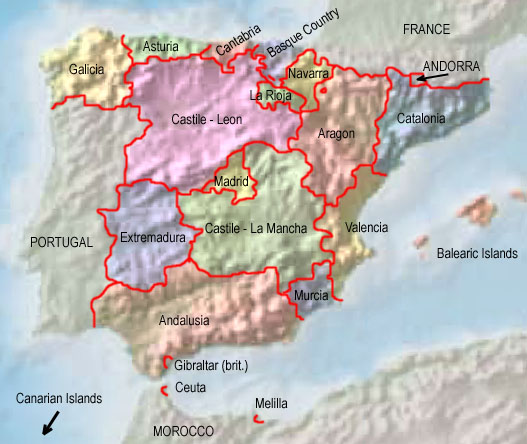
Source: Freeware, University of Texas Libraries, modyfied by: Volker Preuß

Map of the historic Kingdoms on the Iberian Peninsula (ca. 1220):
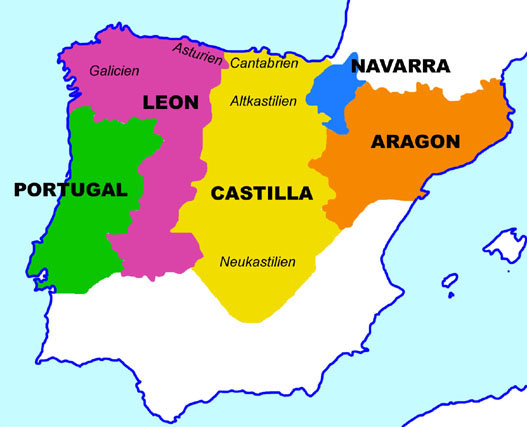
Map: Volker Preuß

Area: 12.390 square miles
Inhabitants: 7.792.611 (2022), thereof ca. 40% Catalans, ca. 55% Castiles and Catalan Castiles, 0,1% Aranese
Density of Population: 629 inh./sq.mi.
Capital: Barcelona, 1.636.193 inh. (2022)
official Languagen: Spanish (Castilan), Catalan, Aranese
Currency: Spanish (Euro) currency
Time Zone: GMT + 1 h
Source: Wikipedia (DE)

early age · settlement by Iberians
ca. 600 B.C. · immigration of Celts, mix with the Iberians, evolution of the Celtiberians
218–201 B.C. · Second Punic War, the Roman Empire acquires the possessions of Carthago in Iberia, subjugation of whole Iberia until the year 19 B.C.
217 B.C. · the today’s Catalonia comes to the Roman province of Hispania Tarraconensis, Roman settlement, romanization
ca. 400 A.D. · Great Transmigration (Migration Period), immigration of Teutonic Alans, teutonic Suebs and Western Goth, some of the Alans settle in the foreland of the Pyrenees Mountains
415 · to the Empire of the Western Goth
711–714 · annihilation of the Empire of the Western Goth by from northern Africa coming Arabs
714 · the Arabs conquer Catalonia
778 · the Frankish Empire under Carl the Great conquers Catalonia, establishment of the Spanish Mark in the foreland of the Pyrenees Mountains, but defeat against the Basques in the Valley of Ronceval
795–812 · re-establishment of the Spanish Mark by Carl the Great and his son Ludvig the Pious
ca.820–ca.880 · crisis of the Frankish Empire after the death of Carl the Great, sharing out of the empire, succession quarrels, the Frankish margrave become banished in the Spanish Mark and were substituted by elected local dynasties, in Catalonia unites Count Wilfried the Hairy (Guifré el Pilós) the Counties of Urgell, Cerdanya, Barcelona and Girona and establishes the dynasty of the Counts of Barcelona which become more and more independent from the Frankish Empire
1137 · Ramiro II., King of Aragon, engages his daughter Pedronella with Raimund Berengar IV., the Count of Barcelona
1150 · wedding of Pedronella and Raimund Berengar
1162 · Alfons II., son of Raimund Berengar becomes Count of Barcelona
1163 · Alfons II. becomes king of Aragon (in this way unification of Aragon and Catalonia)
1172 · Aragon acquires the County of Roussillon and the Cerdagne (momentary even Montpellier and Carcassonne)
1196–1213 · times of the rule of king Pedro II.
1213–1276 · times of the rule of king Jakob I.
1228–1232 · Aragon acquires the Balearic Islands
1238 · liberation of Valencia from the Muslims
1248 · liberation of Alicante from the Muslims
1276–1285 · times of the rule of king Peter III.
1282 · Aragon acquires Sicily Island („Sicilian Vespers”, expulsion of the house of Anjou out of Palermo), war with France
1283 · increase of tax, the estates of Aragon compel from the king the General Privilege of Saragossa
1285–1291 · times of the rule of king Alfons III., wars with Castile and France, the estates become stronger
1291–1327 · times of the rule of king Jacob II., the brother of Alfons III.
1326 · Aragon acquires Sardinia Island
1319 · the non-divisibility of the empire (sharing out because of heritage) becomes fixed by law, furthermore own corporate assemblys (Cortes) in Catalonia and Valencia
1327–1336 · times of the rule of king Alfons IV., the son of Jacob II., wars in alliance with Castile against Genua and the Arabs
1336–1387 · times of the rule of king Peter IV., the son of Alfons IV., end of the war against Genua, partial loss of Sardinia, war against Castile, brother war against the other sons of Alfons IV., the estates become stronger
1387–1395 · times of the rule of king Johann, the son of Peter IV., loss of Sardinia
1410 · death of King Martin, the brother of Johann, vanish of the dynasty of Ramiro of Navarra
1410–1412 · throne quarrels, by arbitrage becomes Ferdinand I. of Castile – a nephew of king Johann - king of Aragon
1412–1416 · times of the rule of king Ferdinand I.
1416–1458 · times of the rule of king Alfons V., the son of Ferdinand I., regency by his consort Maria of Castile and his brother Johann, Alfons V. conquers the Kingdom of Naples (1442) from the house of Anjou and unites Naples and Sicily with Aragon, conflicts with France
1458 · death of Alfons V., his son Ferdinand becomes king in Naples, his brother Johann II. becomes king of Aragon (married with Blanca of Navarra, in this way even king of Navarra, ceding of the Roussillon to France
1479 · death of king Johann II., successor is his son Ferdinand II.
1469 · marriage of Isabella I., Queen of Castile-Leon and Ferdinand II., the Prince and Throne-Successor of Aragon
1479 · coronation of Ferdinand II. and Isabella I. to kings of Spain
1516 · official unification of Aragon and Castile, but Aragon withholds important privileges
1609 · king Philipp III. of Spain banishes the last Muslims (Moresques) out of the country
1701–1714 · Spanish succession war, Aragon positiones itself at the side of Austria, after the defeat loss of the privileges, end of the independent kingship of the United Crown of Aragon, Catalonia, the Balearic Islands and Valencia become outsourced, Aragon (in its today’s borders) and Valencia withhold nominally the title of a kingdom, Catalonia becomes nominally the Principality of Barcelona
1808–1813 · Catalonia is occupied by French troops
1833 · the until that point in time in Spain existing partial kingdoms and regions become divided in provinces, the Principality of Barcelona in the provinces of Lérida, Gerona, Barcelona and Tarragona
1931 · statute of autonomy for Catalonia
1936–1939 · Spanish Civil War, in Catalonia exists until 1938 an "Anarchist Republic" until the conquest by the socialistic governmental troops, since 1938/1939 under control of the troops of General Francol, end of the autonomy
29.09.1977 · Catalonia gets the statute of autonomy within Spain (by summary of the provinces of Lérida, Gerona, Barcelona and Tarragona), establishment of the "Autonomous Community of Catalonia"
7th of May 2006 · revision of the autonomy statute, enlargement of the autonomy rights of Catalonia
27th of October in 2017 · the parliament of Catalonia declares after a referendum the independence of Catalonia from Spain, the central government in Madrid displaces the regional government and orders new elections for Catalonia
Source:
Wikipedia (ES),
World Statesmen,
RetroBib Retrobibliothek,
Volker Preuß

The name "Catalonia" goes back to the here living "Catalans". The name "Catalans" arised in the 5th century as the here living Alans mixed with the Goth to the "Goth-Alans".
Source: Die Völker der Erde


![]()
































